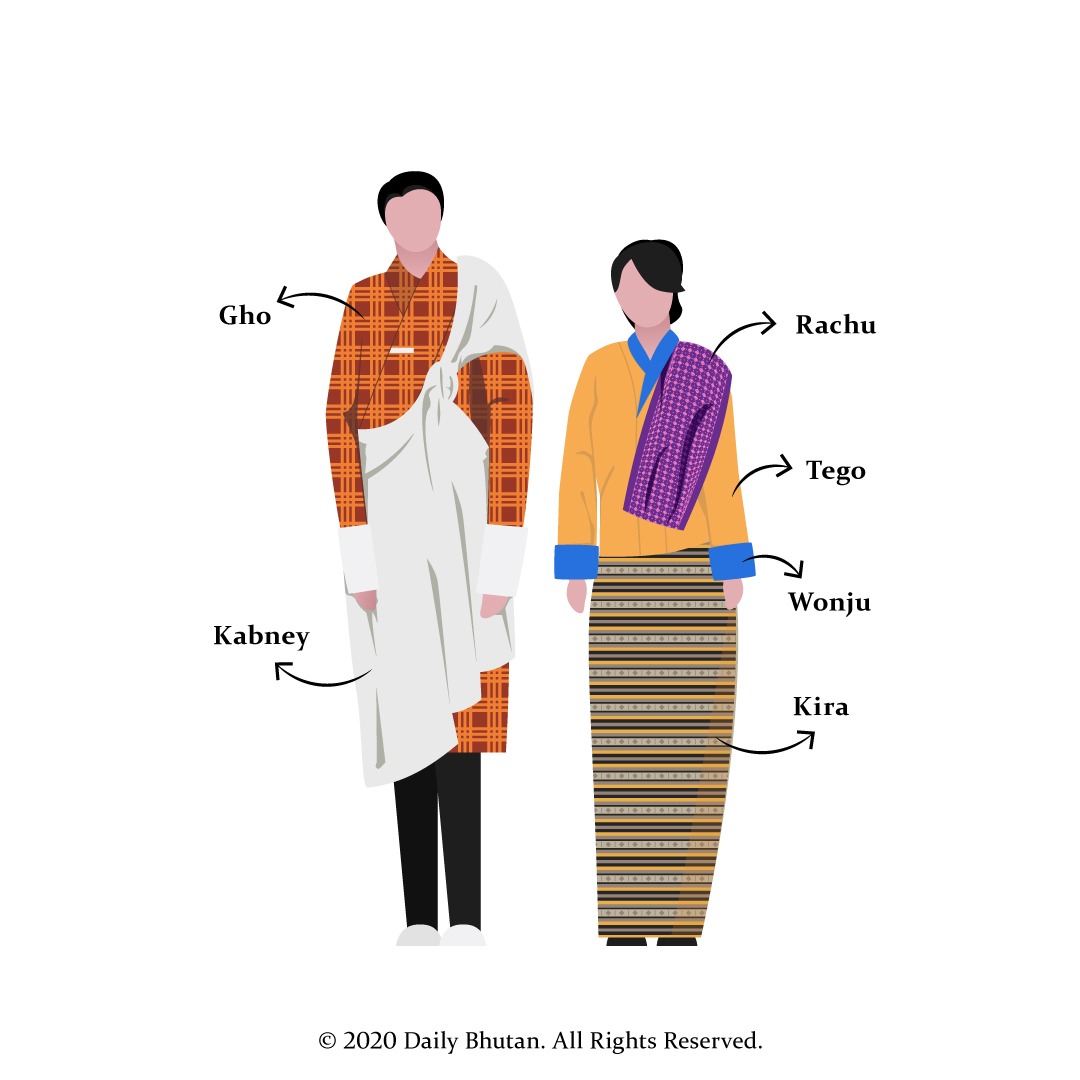bhutanese costume
Introduction
Walk into Bhutan today, and you will see men and women, young and old, clad in their traditional costumes of catchy colours, all made of Bhutanese textile.
The national costumes — gho for men and kira for women — were introduced in the 17th century by Zhabdrung Ngawang Namgyel to provide the Bhutanese with a unique identity.
And in an effort to promote its cultural heritage, since 1989, it has been made compulsory for Bhutanese to wear their traditional costume in school, government offices, during festivals, and on important occasions.
- Gho
Some tourists might be puzzled when they see Bhutanese men in dresses, but make no mistake, this is no western dress; it is the gho.
Gho is the national attire for Bhutanese men, a long robe similar to the Tibetan chuba. It hangs till the knees. It is typically of plaid or striped design, and can be of any colour.
Nonetheless, flowered patterns are a taboo, and solid reds and yellows are avoided because they are associated with the monks and royals respectively.
The upper half of the gho serves as a pocket. Some joke that the pocket is so huge that they can carry their baby in it. "The world's largest pocket", they say.
Traditionally, a Bhutanese man wears under his gho what a true Scotsman wears under his kilt—nothing. But nowadays, the Bhutanese men usually wear a pair of shorts.
During the winter, they normally wear jeans or tracksuits.
In Thimphu, the rule of thumb is that legs should not be covered until winter arrives, and this is defined as when the monks move to Punakha.

- Kera
The gho is held in place by a woven cloth belt called kera. The kera not only adds aesthetic value, but also forms a large pouch that was traditionally used to carry a bowl and a small dagger.
Nowadays, Bhutanese use it to carry their wallet and mobile phone.
One man shared that everyday, he looked forward to loosening the tight kera around his waist.
- Kira
The apron-like dress popular among the Bhutanese womenfolk is called the kira. It is ankle-length and is basically a rectangular piece of cloth that wraps around the body. Bhutanese women either wear a full kira (like a dress) or a half kira (like a skirt).
The kira is fastened at the shoulders by complicated silver hooks called koma, and at the waist with a belt that could be either silver or cloth.
For day-to-day wear, women usually wear kiras made of striped cloth with a double-sided design, whereas on special occasions, they wear bright coloured kiras with dazzling patterns and embroideries.

Check out the exquisite kiras worn by the gorgeous Queen of Bhutan.
- Wonju
Underneath the kira is a long-sleeved blouse called the wonju. They come in different patterns and colours, and can be found in a range of different materials.

- Toego or Tego
To spruce up the kira is the toego, a short, jacket-like garment. It is usually of a different pattern, fabric, and colour from the long robe.
- Rachu
When attending formal gatherings or visiting a place of worship, the women drapes a ceremonial scarf over their left shoulders, as a mark of respect.
This scarf is called a rachu. It is part of the full formal attire when entering important places such as government offices or the dzongs (ancient fortresses). It is usually colourful and comes in different patterns and designs.

- Kabney
Meanwhile, Bhutanese men wear kabney, a ceremonial scarf that is slung across the shoulder. Similar to the rachu, a kabney is required when a male enters the dzong or government offices.
The colour of the kabney depends on the position the person holds in Bhutanese society. When meeting a person of higher position, or attending important national events, Bhutanese are to adhere to this protocol.

The King of Bhutan adorns a yellow kabney. As the highest ranked individual in Bhutan, his kabney is quite distinct.

The Evolution of the Kira
Although Bhutan’s traditional costume is and will continue to be a staple for ages to come, it has seen its own evolution over the years, especially the kira.
Check out the video on the evolution of kira by Bhutan Street Fashion and Team Bhutan Production.
Once upon a time in the 1930s, the kira was more playful. A typical kira entailed a single rectangular cloth wrapped around the wearer with a hem that teased around the calves.
Comments
Post a Comment